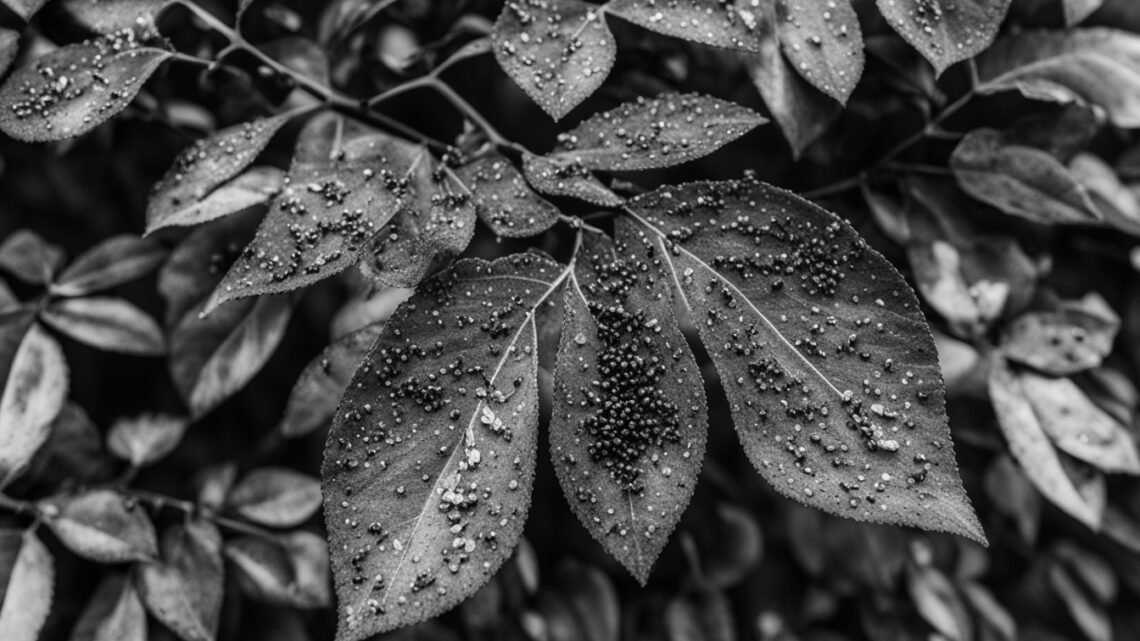
Have you ever wondered how to deal with the insects that harm your fruit trees? This guide will show you how to spot and manage these pests. We’ll cover the common pests and how to keep your trees healthy.
What are the main pests in fruit tree orchards? How do you know they’re there? We’ll look at pests like the European red mite and the Japanese beetle. Learn about their looks and how they damage trees. This will help you use a smart pest control plan that protects your trees and the environment.
Common Insect Pests on Fruit Trees
Fruit trees like pome fruits (apples, pears), stone fruits (peaches, plums), nut trees, and berry crops face many insect pests. These pests can harm their health and how much they produce. The European red mite and the woolly apple aphid are two big problems.
European Red Mite
The European red mite eats the leaves of fruit trees, causing leaf bronzing. This makes the tree less able to make sugars. It leads to premature leaf drop and reduced fruit set. To fight this, use dormant oils and insecticides that don’t harm good bugs.
Woolly Apple Aphid
The woolly apple aphid lives on tree wounds, including roots. It can stop young trees from growing or even kill them. It’s important to check for these aphids and use the right controls to keep trees healthy.
Knowing about these pests helps fruit growers protect their trees. This way, they can have a good harvest every year.
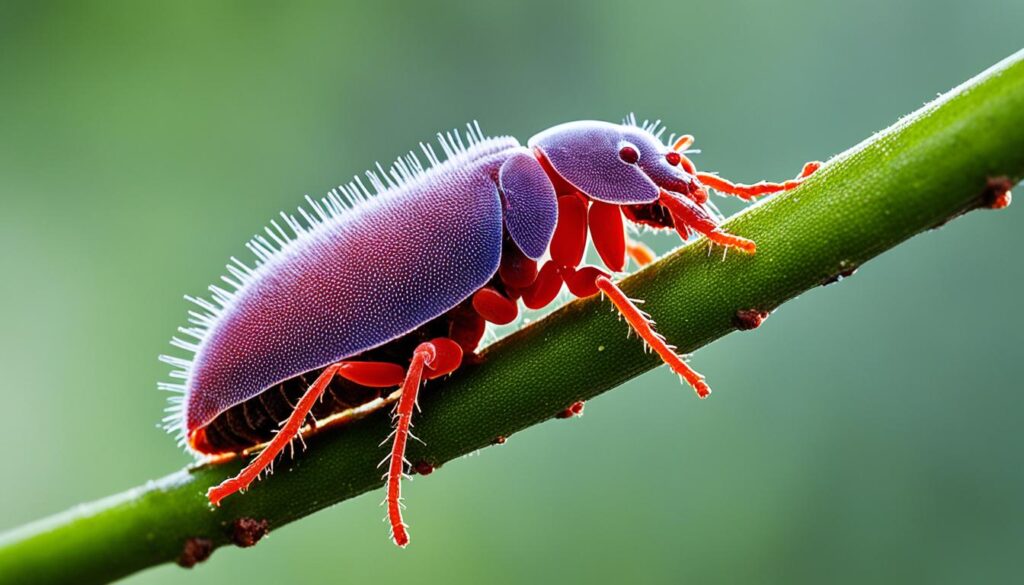
Identifying Insect Damage on Fruit Trees
It’s key to spot insect damage on fruit trees to manage pests well. Look for chewing marks and fruit scars to figure out who’s causing the trouble. This helps growers act fast.
Signs of Chewing and Feeding
Check for chewing on leaf edges or small holes in fruit. These could mean pests like codling moth larvae or Japanese beetles are around. Rolled or curled leaves might show aphids or other insects eating sap.
Distinguishing Fruit Scars
Scars on fruit can tell you what insect is there. Plum curculio leaves fan-shaped scars, while fruit flies make tunnels and decay. Corky indentations might mean orchard moths are there.
Talk to experts and use guides to get better at spotting insect pests. With a sharp eye, you can catch insect damage early and manage it well in your orchard.
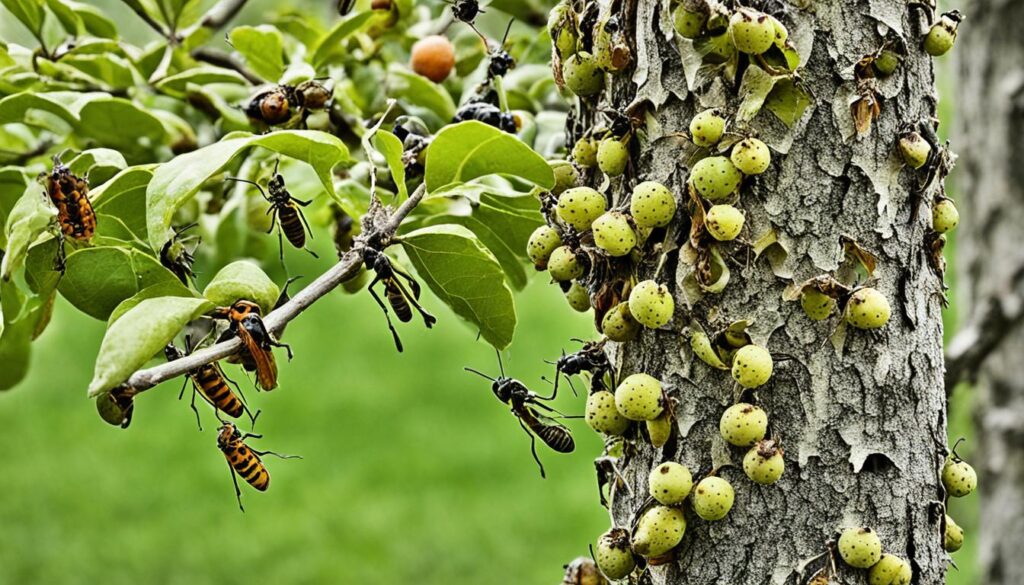
Orchard Pest Management Strategies
Managing pests in orchards needs a full plan. This plan includes watching pests, scouting, and using organic and chemical controls wisely. By watching pests and acting early, you can stop damage and keep good insects safe. These insects are key to managing pests well.
Monitoring and Scouting
Watching pests and scouting is key to knowing when to act. This way, you don’t over-control and upset the balance in your orchard. By watching your trees and seeing how many pests there are, you can decide when to use controls.
Organic and Chemical Controls
When pests are a problem, using both organic and chemical controls can help. Organic methods like pheromone traps, biological pesticides, and helping good insects are important. They help manage pests without hurting the environment. Chemical sprays might be needed for big problems, but aim to keep damage small and protect good insects.
Dealing with pests in orchards is tough, but a full, integrated plan can help. With careful watching, creativity, and a focus on sustainability, you can keep your fruit trees healthy. This way, you can have plenty of fruit every year.
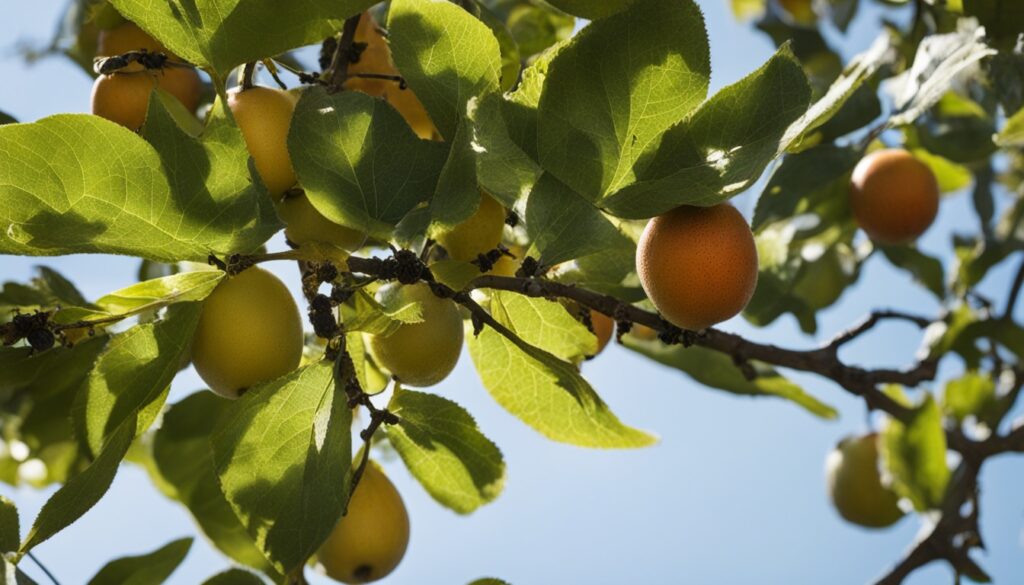
insect pests on fruit trees: A Comprehensive Guide
Keeping fruit trees healthy and productive means knowing about the pests that can harm them. Learn about the pests, their damage, and how to manage them. This knowledge helps you use a sustainable pest management plan for your trees.
The European red mite (Panonychus ulmi) is a common pest that hides in tree bark during the cold months. To control it, use dormant oil before the trees bloom and insecticides if needed. The woolly apple aphid also bothers trees, feeding on leaves and roots. Watch for pruning scars and act when there are 10% infested trees to stop them.
Knowing how to spot pest damage is key to fighting pests. Look for chewed leaves, sticky spots, and marks on fruit. Seeing the ‘c-shaped’ wounds from plum curculio on fruit helps you target your control efforts.
Use a mix of organic and chemical methods to keep pests away. Regular checks and scouting help you manage pests without harming the environment. This guide gives you the tools to protect your trees and keep your orchard healthy and sustainable.

Sustainable Orchard Pest Control
An integrated pest management (IPM) approach is key for a healthy orchard. IPM uses monitoring, organic methods, and targeted chemicals to protect trees safely. By knowing pests’ life cycles and weaknesses, you can reduce damage and protect good insects while cutting down on harsh chemicals.
- Check your trees often for signs like curled leaves, sticky spots, and fruit marks.
- Use organic controls like insecticidal soap, neem oil, and helpful insects.
- Apply chemicals like systemic insecticides and miticides only when really needed.
- Keep trees healthy with good watering, feeding, and pruning to boost their defense.
With a strong and sustainable pest management plan, you can shield your fruit trees from pests. This approach helps keep your orchard healthy and full of life.
The Orchard Moth Complex
The «orchard moth complex» includes many moth species that harm fruit trees. Their larvae eat the leaves and the fruit that is growing. Some larvae go inside the fruit to eat the seeds. Others make marks on the fruit’s skin.
Moth Life Cycles
Knowing how these moths live is important for controlling them. Codling moth can have up to three generations a year. Adults start showing up in May in some areas, and in others a week later.
Controlling Moth Larvae
Using traps for adult moths and counting degree-days helps target the young ones. You can use organic or chemical methods to control them. Removing infested fruit and thinning fruit can also help. Encouraging natural enemies like wasps and earwigs is a good way to keep pests down.
| Pest | Monitoring | Management Strategies |
|---|---|---|
| Codling Moth | Pheromone traps, Degree-day models | Insecticides, Fruit thinning, Fruit bagging |
| Leaf Roller Moths | Pheromone traps, Monitoring larval activity | Bacillus thuringiensis (Bt), Mating disruption |
| Fruitworms | Pheromone traps, Monitoring early larval activity | Spinosad, Pheromone mating disruption |
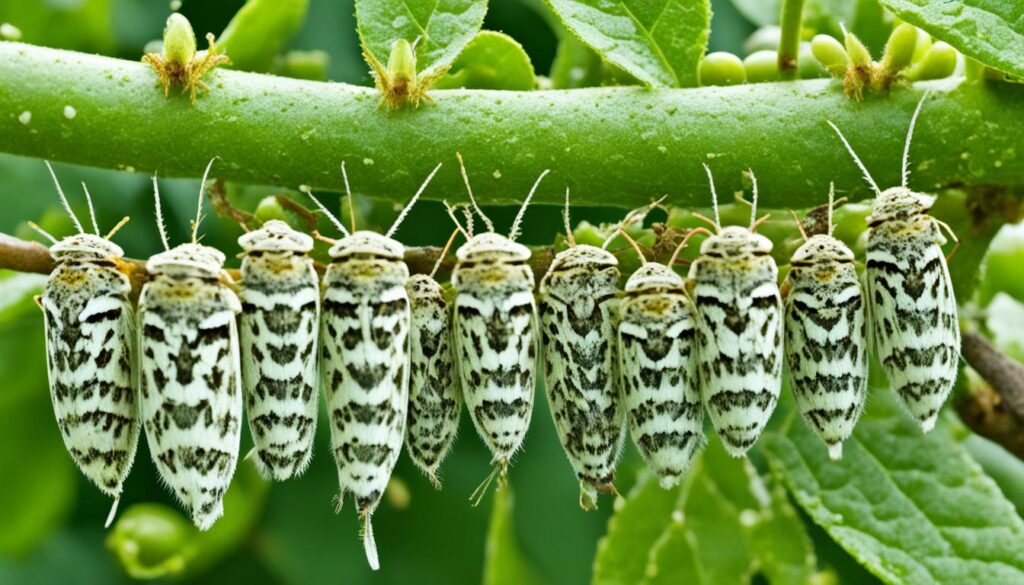
Managing Fruit Flies in the Orchard
Fruit-feeding flies like the apple maggot fly and cherry fruit fly are big problems for orchard owners. They lay eggs inside the fruit, causing damage and decay. To manage these pests, we need to attack them at different stages of their life.
Using feeding attractants to catch adult flies is a good strategy. These attractants, with sticky sphere traps, can stop egg-laying females. Also, using Steinernema feltiae or Beauveria bassiana in the soil can break the pest’s life cycle.
Planting «trap trees» is another way to control fruit flies. These trees attract the flies, making it easier to manage them in the orchard.
By combining these methods, orchard owners can fight fruit flies, maggot flies, apple maggot fly, and cherry fruit fly infestations. This helps protect their fruit from damage.
| Pest | Damage Impact | Control Measures |
|---|---|---|
| Apple Maggot Fly | Up to 100% fruit damage when uncontrolled |
|
| Spotted Wing Drosophila | Rapid life cycle and ability to lay eggs in unbroken fruit |
|
Dealing with Sawflies and Beetles
Orchards face big challenges from sawflies and beetles, like the plum curculio. Sawfly larvae, or «pear slugs,» eat leaves. Apple sawfly larvae eat into fruit.
Curculio beetles, like the plum curculio, make «c-shaped» wounds in fruit to lay eggs. Their larvae then eat from the inside.
Identifying Sawfly Damage
Sawflies (Caliroa cerasi) are pests of fruit trees like cherry, plum, and pear. Their larvae can strip leaves off trees. Adults lay eggs in leaves in late spring.
The larvae that hatch later can cause a lot of damage, especially to young trees. This happens in late July and August.
Curculio Beetle Control
To fight these pests, use repellents and trap trees. Apply organic or chemical sprays when the larvae are most vulnerable. Nematodes like Steinernema feltiae can also be used to target the larvae in the soil.
| Pest | Identification | Control Measures |
|---|---|---|
| Sawflies | Larvae can skeletonize leaves; adults are about 5/16 inch long | Sticky traps, organic sprays, beneficial nematodes |
| Curculio Beetles | Chew distinctive «c-shaped» wounds in fruit for egg-laying | Repellents, trap trees, targeted sprays |
Understanding these pests helps growers use the best pest control methods. This protects their fruit crops.
Japanese Beetle: A Voracious Orchard Pest
The Japanese beetle (Popillia japonica) is a big problem in orchards. These shiny beetles eat the leaves, flowers, and fruits of many trees and plants. They can fly far and eat on many things, making them hard to control.
Adult Japanese beetles start coming out in mid-to-late May. They like it when it gets hot, over 70°F. They eat leaves and fruits in groups, causing a lot of damage. The first time they were seen in the U.S. was in 1916 in New Jersey. By 1920, they had already damaged trees in 22 states.
To fight these pests, you might want to use Sevin brand garden insecticides. These products kill over 130 pests but are safe for plants. Sevin Insect Killer Ready To Spray and Sevin Insect Killer Lawn Granules can protect your garden for up to three months.
Other ways to control them include getting rid of plants they like, tilling the soil, and using cover crops. These methods can help reduce their numbers in your orchard.



